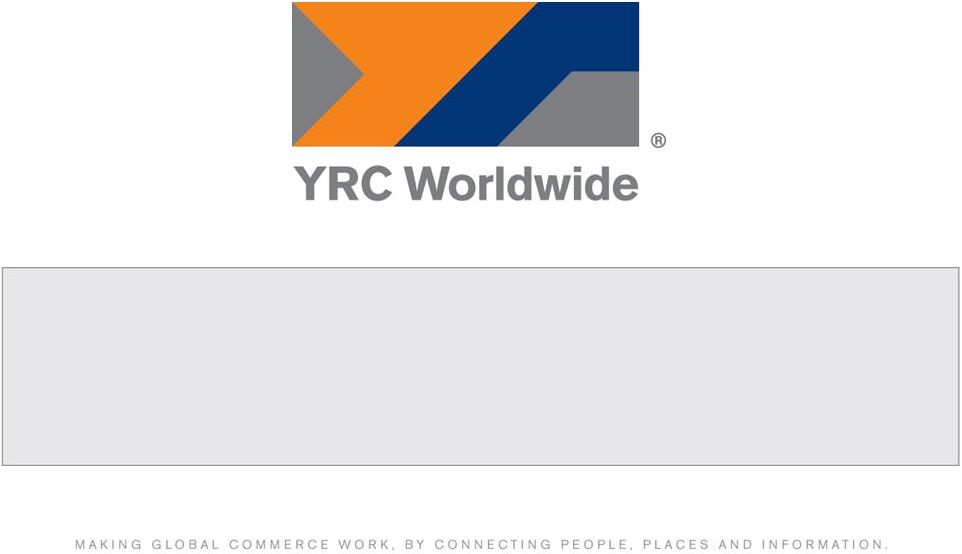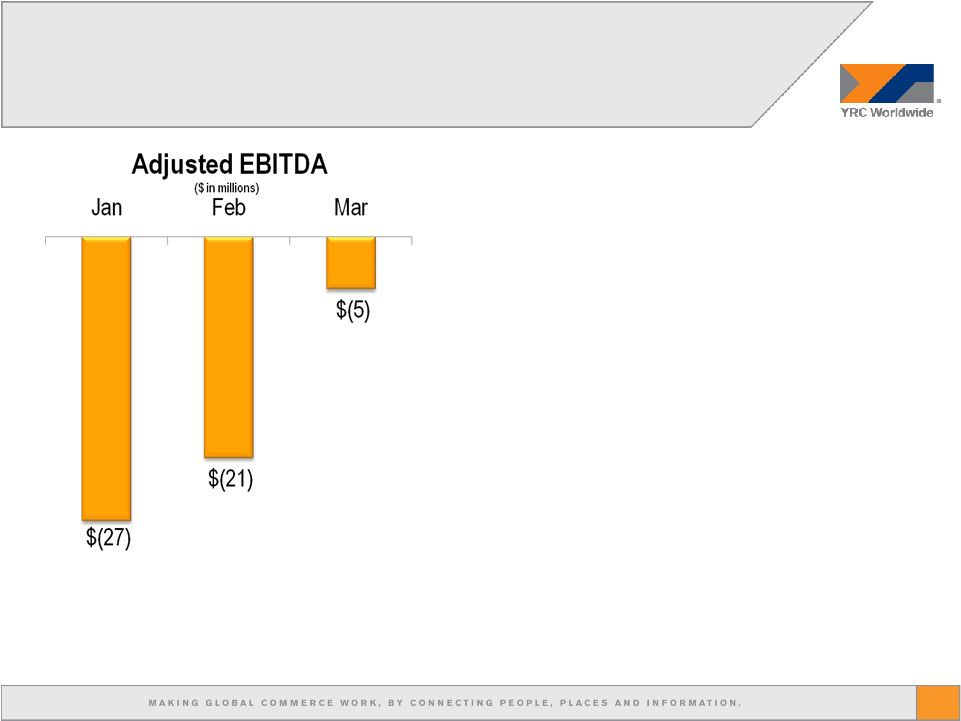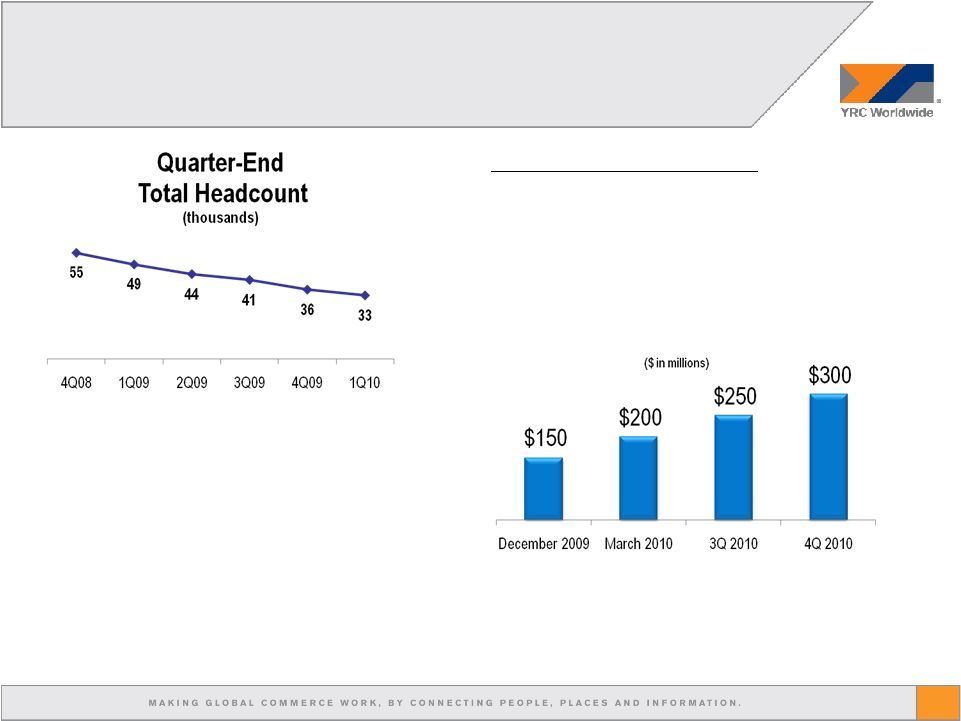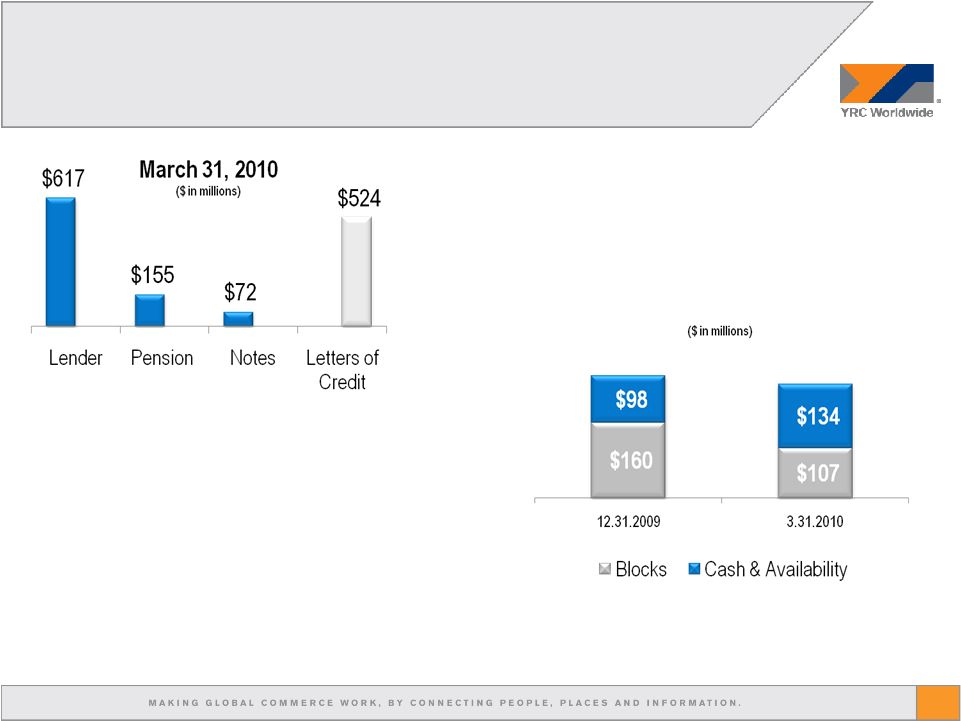Attached files
| file | filename |
|---|---|
| 8-K - FORM 8-K - Yellow Corp | d8k.htm |
| EX-99.1 - NEWS RELEASE DATED MAY 24, 2010 - Yellow Corp | dex991.htm |
 Investor
Presentation Investor Presentation
May 2010
Exhibit 99.2 |
 2
Discussion Topics
Discussion Topics
•
New Directors and Annual Shareholder Meeting
•
Multi-Employer Pension Reform
•
Operating Improvement
•
Cost Reductions
•
Capital Structure
•
2010 Expectations |
 3
New Directors / Annual Shareholder Meeting
New Directors / Annual Shareholder Meeting
Effective May 11, 2010, the Board of Directors elected Marnie S.
Gordon, Beverly K. Goulet, Mark E. Holliday, John A. Lamar,
Eugene I. Davis, Dennis E. Foster and William L. Trubeck to fill
the
vacancies left by the resigning directors
Teresa Ghilarducci has been nominated by the International
Brotherhood of Teamsters per the July 2009 amendment to our labor
agreement
Annual Shareholder meeting June 29, 2010 |
 4
Multi-Employer Pension Reform
Multi-Employer Pension Reform
•
Temporary relief in the form of amortization extension is expected
to pass soon
•
The joint labor management coalition has conducted hundreds of
Capitol Hill visits
•
Congress hears our message, and the issue has bipartisan
support
•
Senate HELP Committee hearing set for May 27 on multi-employer
pension plans |
 2010
Consolidated Operating Trends 2010 Consolidated Operating Trends
5
Adjusted EBITDA is a non-GAAP measure that reflects the company’s earnings
before interest, taxes, depreciation, and amortization expense, and further
adjusted for letter of credit fees and other items as defined in the company’s Credit Agreement. Adjusted EBITDA is used for internal
management purposes as a financial measure that reflects the company’s core
operating performance and is used by management to measure compliance with
financial covenants in the company’s Credit Agreement. This financial measure should not be construed as a better measurement than
operating income as defined by generally accepted accounting principles. See Pages
13 and 14 for a reconciliation of consolidated and segment GAAP
measures to non-GAAP financial measures.
•
Sequential improvement continues into April
•
April at adjusted EBITDA break even
•
Expect YRCW adjusted EBITDA positive in
2Q10
•
Expect Regional segment to be operating
income positive in 2Q10
•
Volume growth, revenue mix management
and cost actions |
 6
Total Headcount Scaling / 2010 Cost Out
Total Headcount Scaling / 2010 Cost Out
Note: Above 2010 cost out program is incremental to 3Q09 results; 4Q09 and
1Q10 as reported benefit was $15 million and $40 million respectively; $300
million run rate cost outs exclude benefits from network changes; 4Q09 network
consolidations expected to produce $20 million annual run rate benefit in
2010. 2010 Cost Out –
Run Rate
•
SG&A reductions
•
Operational process improvements
•
Safety improvements
•
Successfully scaling headcounts
•
Streamlined organization
•
Process improvements |
 7
Debt / Liquidity
Debt / Liquidity
•
Debt is primarily lender borrowings and
letters of credit obligations
•
Credit agreement matures August 2012
•
364-day asset-backed securitization facility
matures October 2010
•
New block requires two-thirds lender vote
•
Liquidity required to fund working capital to
support sequential revenue growth
Note: Cash maturities of $844 million at March 31, 2010 consist of $72M notes (new
6% notes of $50M and remaining 5% and 3.375% notes of $22M); $155M pension
debt; and $617M lender debt ($388M revolver/ $111M term Loan/ $118M ABS). Non-cash maturity obligation related to sale/leaseback debt (per
GAAP balance sheet) of $320M is satisfied by transfer of title to underlying real estate
at the inception of the initial sale and leaseback transaction. |
 8
Authorized
Outstanding
@ 3.31.2010
(1)
$70M
6% Notes
$.43/share
(2)
Options /RSU’s
@ 12.31.2009
(3)
Teamster
Options
$.48/share
(4)
Remaining
@ 3.31.2010
(5)
Common Shares
2 billion
1.054 billion
202 million
18 million
264 million
462 million
Range of shareholder-approved post-split number of shares:
@ 1:25
80 million
42 million
8 million
1 million
11 million
18 million
@ 1:5
400 million
211 million
40 million
4 million
53 million
92 million
Common Shares and Post-Split Range
•
Shareholder-approved reverse stock split range of ratios is 1:25 to 1:5
•
Timing and ratio at discretion of the YRCW Board
(1) Per 10K / A (all of the YRCW convertible class A preferred stock has converted to
common stock) (2) Pro forma amounts, assuming all notes are issued and
converted; conversion rate $.43 per share for par value plus interest and make whole paid in shares
(3) Per 2009 10K; includes existing Teamster and non-union options from 2009
(4) Per 8K March 2010; new Teamster equity-based awards issued as stock appreciation
rights, pending shareholder approval of options ; strike price $.48 per share
(5) Per 2009 note exchange offer the 5% management equity award program is approximately
67 million shares and is subject to shareholder approval; net remaining shares approximately 400 million.
At-the-market program announced on May 4, 2010 for up to $103 million of
shares of common stock. |
 2010
Expectations 2010 Expectations
•
YRCW positive adjusted EBITDA in 2Q
•
Regional Transportation segment operating income positive in 2Q
•
Gross capital expenditures of approximately $50 million
•
Real estate sales in the range of $25 to $50 million
•
Sale and financing leasebacks of up to $50 million, primarily in
the
second half of the year
•
Interest expense in the range of $40 to $45 million per quarter,
with cash interest of $10 million to $12 million per quarter
•
Effective income tax rate of 2%
9 |
 10
Forward-Looking Statements
Forward-Looking Statements
This presentation contains forward-looking statements within the meaning of Section
27A of the Securities Act of 1933, as amended, and Section 21E of the Securities
Exchange
Act
of
1934,
as
amended.
The
words
“believe,”
“expect,”
“continue,”
and
similar
expressions
are
intended
to
identify
forward-looking
statements.
It
is
important to note that the company’s actual future results could differ materially
from those projected in such forward-looking statements because of a number of
factors, including (among others) our ability to generate sufficient cash flows and
liquidity to fund operations, which raises substantial doubt about our ability to
continue
as
a
going
concern,
inflation,
inclement
weather,
price
and
availability
of
fuel,
sudden
changes
in
the
cost
of
fuel
or
the
index
upon
which
the
company
bases
its fuel surcharge, competitor pricing activity, expense volatility, including (without
limitation) expense volatility due to changes in rail service or pricing for rail
service, ability to capture cost reductions, changes in equity and debt markets, a
downturn in general or regional economic activity, effects of a terrorist attack, labor
relations, including (without limitation) the impact of work rules, work stoppages,
strikes or other disruptions, any obligations to multi-employer health, welfare and
pension plans, wage requirements and employee satisfaction, and the risk factors that are
from time to time included in the company’s reports filed with the SEC. The
company’s expectations regarding the impact of, and the service and operational improvements and collateral and cost reductions due to, the integration of
Yellow
Transportation and Roadway, improved safety performance, right-sizing the network,
consolidation of support functions, the company’s credit ratings and the
timing of achieving the improvements and cost reductions could differ materially from
actual improvements and cost reductions based on a number of factors,
including
(among
others)
the
factors
identified
in
the
preceding
and
following
paragraphs,
the
ability
to
identify
and
implement
cost
reductions
in
the
time
frame
needed
to achieve these expectations, the success of the company’s operating plans and
programs, the company’s ability to successfully reduce collateral
requirements for its insurance programs, which in turn is dependent upon the
company’s safety performance, ability to reduce the cost of claims through claims
management,
the
company’s
credit
ratings
and
the
requirements
of
state
workers’
compensation
agencies
and
insurers
for
collateral
for
self-insured
portions
of
workers’
compensation programs, the need to spend additional capital to implement cost reduction
opportunities, including (without limitation) to terminate, amend or renegotiate
prior contractual commitments, the accuracy of the company’s estimates of its spending requirements, changes in the company’s strategic direction, the
need to replace any unanticipated losses in capital assets, approval of the affected
unionized employees of changes needed to complete the integration under the
company’s union agreements, the readiness of employees to utilize new combined
processes, the effectiveness of deploying existing technology necessary to
facilitate
the
combination
of
processes,
the
ability
of
the
company
to
receive
expected
price
for
its
services
from
the
combined
network
and
customer
acceptance
of
those services.
The
company’s
expectations
regarding
its
ability
to
satisfy
Nasdaq
listing
requirements
for
minimum
bid
price
of
the
company’s
common
stock
are
only
its
expectations
regarding
this
matter.
The
closing
bid
price
of
the
company’s
common
stock
depends
on
many
factors,
including
without
limitation,
actual
or
expected
fluctuations in the company’s operating results, changes in general economic
condition or conditions in the company’s industry generally, changes in conditions in
the
financial
markets,
the
effect
of
any
issuance
of
additional
shares
of
the
company’s
common
stock
and
whether
the
company’s
board
of
directors
effects
a
reverse
stock
split
and
the
timing
of,
and
the
reverse
stock
split
ratio
for,
any
reverse
stock
split
approved
by
the
board. |
 11
Forward-Looking Statements
Forward-Looking Statements
The
company’s
expectations
regarding
its
ability
to
close
on
the
remaining
$20.2
million
of
6%
notes
are
only
its
expectations
regarding
this
matter.
The
closing
of
the
second $20.2 million of the 6% notes is subject to a number of conditions, including
(among others), a determination of the outcome of the company’s litigation with
respect to its outstanding 5% and 3.375% contingent convertible notes.
The
company’s
expectations
regarding
its
ability
to
raise
new
capital
in
the
equity
markets,
including
through
at-the-market
transactions,
are
only
its
expectations
regarding this matter.
Whether the company is able to raise new capital is dependent upon a number of factors
including (among others) the trading price and volume of the company’s common
stock and the company reaching agreement with interested investors and closing such transactions on negotiated terms and conditions,
including (without limitation) any closing conditions that investors may require.
The company’s expectations regarding shareholder approval of the Second Union
Employee Option Plan and an increase in the shares available for issuance from the
company’s
2004
Long-Term
Incentive
and
Equity
Award
Plan
are
only
its
expectations
regarding
this
matter.
To
be
approved
by
the
Company’s
shareholders,
the
plans must be approved by a majority of the votes cast, in person or by proxy, at a
shareholder meeting. If shareholders approve the option plan, the stock
appreciation rights granted to union employees in March 2010 will terminate. If
shareholders do not approve the option plan by February 28, 2011, the stock options
will terminate and the market price per share in excess of the $0.48 strike price per
stock appreciation right would be cash-settled upon their exercise, which can occur
beginning March 1, 2011.
The
company’s
expectations
regarding
the
timing
and
degree
of
market
share
growth
are
only
its
expectations
regarding
these
matters.
Actual
timing
and
degree
of
market share growth could differ based on a number of factors including (among others)
the company’s ability to persuade existing customers to increase shipments
with the company and to attract new customers, and the factors that affect revenue
results (including the risk factors that are from time to time included in the
company’s reports filed with the SEC).
The
company’s
expectations
regarding
multi-employer
pension
plan
reform
are
only
its
expectations
regarding
this
matter.
The
impact
to
the
company
and
the
multi-
employer
pension
plans
to
which
it
contributes
of
such
reform
is
subject
to
a
number
of
conditions,
including
(among
others)
whether
Congress
passes
legislation
to
reform multi-employer pension plans and the timing of, and provisions included in,
such legislation. The company’s expectations regarding its capital
expenditures are only its expectations regarding this matter. Actual expenditures could differ materially based on a
number of factors, including (among others) the factors identified in the preceding and
following paragraphs. |
 12
Forward-Looking Statements
Forward-Looking Statements
The company’s expectations regarding future asset dispositions and sale and
financing leasebacks of real estate are only its expectations regarding these matters.
Actual dispositions and sale and financing leasebacks will be determined by the
availability of capital and willing buyers and counterparties in the market and the
outcome of discussions to enter into and close any such transactions on negotiated terms
and conditions, including (without limitation) usual and ordinary closing
conditions such as favorable title reports or opinions and favorable environmental
assessments of specific properties. The company’s expectations regarding interest and fees (including any deferred
amounts) are only its expectations regarding these matters. Actual interest and
fees (including any deferred amounts) could differ based on a number of factors,
including (among others) the company’s expected borrowings under the
company’s credit agreement and the ABS facility, which is affected by revenue and
profitability results and the factors that affect revenue and profitability results
(including the risk factors that are from time to time included in the company’s
reports filed with the SEC), and the company’s ability to continue to defer the
payment of interest and fees pursuant to the terms of the company’s credit
agreement, ABS facility and pension fund contribution deferral agreement, as
applicable.
The company’s expectations regarding its effective tax rate are only its
expectations regarding this rate. The actual rate could differ materially based on a number
of factors, including (among others) variances in pre-tax earnings on both a
consolidated and business unit basis, variance in pre-tax earnings by jurisdiction,
impacts on our business from the factors described above, variances in estimates on
non-deductible expenses, tax authority audit adjustments, change in tax rates
and availability of tax credits. The company’s expectations regarding the continued support of its stakeholders are
only its expectations regarding this matter. Whether the company’s
stakeholders continue to support the company including (among other things) to continue
deferral arrangements in 2011 or to restructure obligations owed to such
stakeholders is subject to a number of conditions including (among other things) the outcome of discussions with such stakeholders, whether requested
support meets their requirements and the factors identified in the preceding paragraphs.
The company’s expectations regarding liquidity are only its expectations regarding
this matter. Actual liquidity levels will depend upon (among other things) the
company’s operating results, the timing of its receipts and disbursements, the
company’s access to credit facilities or credit markets, the company’s ability to
continue to defer interest and fees under the company’s credit agreement and ABS
facility and interest and principal under the company’s contribution deferral
agreement, the continuation of the existing union wage reductions and temporary cessation
of pension contributions, and the factors identified in the preceding paragraphs.
|
 Operating
Loss to Adjusted EBITDA Operating Loss to Adjusted EBITDA
13
Adjusted EBITDA margin is Adjusted EBITDA divided by operating revenue expressed as
a percentage. $ in millions
Jan '10
Feb '10
Mar '10
Q1 '10
Consolidated
Operating revenue
323
$
329
$
412
$
1,063
$
Operating loss
(49)
$
(42)
$
(146)
$
(237)
$
Depreciation and amortization
17
17
18
52
Equity based compensation expense
1
1
108
110
Letter of credit expense
3
3
3
9
Losses on property disposals, net
-
-
9
9
Impairment charges
-
-
5
5
Other, net
1
-
(2)
(1)
Adjusted EBITDA
(27)
$
(21)
$
(5)
$
(53)
$
Adjusted EBITDA margin
-8.4%
-6.4%
-1.2%
-5.0% |
 Operating
Loss to Adjusted EBITDA Operating Loss to Adjusted EBITDA
14
Workdays are the number of calendar days during each quarter exclusive of weekends
and holidays. Adjusted EBITDA margin is Adjusted EBITDA divided by operating
revenue expressed as a percentage. Adjusted EBITDA per workday is Adjusted
EBITDA divided by the workdays. $ in millions
Jan '10
Feb '10
Mar '10
Q1 '10
National
Workdays
20.0
20.0
23.0
63.0
Operating revenue
203
$
206
$
254
$
663
$
Operating loss
(39)
$
(33)
$
(113)
$
(185)
$
Depreciation and amortization
9
9
9
27
Equity based compensation expense
-
-
83
83
Letter of credit expense
3
2
2
7
(Gains) losses on property disposals, net
(1)
-
6
5
Impairment charges
-
-
3
3
Other, net
-
1
(1)
-
Adjusted EBITDA
(28)
$
(21)
$
(11)
$
(60)
$
Adjusted EBITDA margin
-13.8%
-10.2%
-4.3%
-9.0%
Adjusted EBITDA per workday - $000s
(1,400)
$
(1,050)
$
(478)
$
(952)
$
Regional
Workdays
20.0
20.0
24.5
64.5
Operating revenue
92
$
93
$
124
$
309
$
Operating loss
(6)
$
(5)
$
(29)
$
(40)
$
Depreciation and amortization
5
5
6
16
Equity based compensation expense
-
-
24
24
Letter of credit expense
-
1
1
2
Losses on property disposals, net
1
-
3
4
Impairment charges
-
-
2
2
Other, net
-
-
-
-
Adjusted EBITDA
-
$
1
$
7
$
8
$
Adjusted EBITDA margin
0.0%
1.1%
5.6%
2.6%
Adjusted EBITDA per workday - $000s
-
$
50
$
286
$
124
$ |
